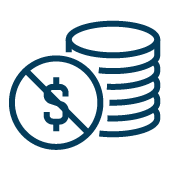Time flies when you’re having fun. And the sooner you start saving for retirement, the longer you’ll keep the good times coming.
Key Features
-
 Competitive Dividends
Competitive Dividends
-
 No Maintenance Fee
No Maintenance Fee
-
 Tax Advantages*
Tax Advantages*
- Competitive interest above standard savings rates
- Traditional and Roth IRA options
- No setup fees
- No monthly or annual maintenance fees
- Annual contribution limits apply (see current contribution limits; $6,000 as of 2019)1
- Additional $1,000 "catch-up" contribution allowed for ages 50+
- Funds can be used to purchase CDs within IRA
- No minimum deposit to open
1Consult a tax advisor.
There are advantages to both traditional and Roth IRAs. One of the biggest differences is the time at which you see the most advantage. A traditional IRA provides potential tax relief today, while a Roth IRA has the potential for the most tax benefit at time of retirement.
Traditional IRA
- No income limits to open
- No minimum contribution requirement
- Contributions are tax deductible on state and federal income tax1
- Earnings are tax deferred until withdrawal (when usually in lower tax bracket)
- Withdrawals can begin at age 59½
- Early withdrawals subject to penalty2
- Mandatory withdrawals at age 72 (or earlier if you have turned age 70½ in 2019 or before.)
Roth IRA
- Income limits to be eligible to open Roth IRA3
- Contributions are NOT tax deductible
- Earnings are 100% tax free at withdrawal1
- Principal contributions can be withdrawn without penalty1
- Withdrawals on interest can begin at age 59½
- Early withdrawals on interest subject to penalty2
- No mandatory distribution age
- No age limit on making contributions as long as you have earned income
1Subject to some minimal conditions. Consult a tax advisor.
2Certain exceptions apply, such as healthcare, purchasing first home, etc.
3Consult a tax advisor.
Create an easier transition into college for yourself and your student by setting up a savings account early. A Coverdell Education Savings Account (ESA) provides a tax-free safe place to grow competitive dividends and also financial confidence for a new stage in life.
- Set aside funds for your child's education
- No setup or annual fee
- Dividends grow tax-free
- Withdrawals are tax-free and penalty-free when used for qualified education expenses1
- Designated beneficiary must be under 18 when contributions are made
- To contribute to an ESA, certain income limits apply2
- Contributions are not tax deductible
- $2,000 maximum annual contribution per child
- The money must be withdrawn by the time he or she turns 303
- The ESA may be transferred without penalty to another member of the family
- No minimum deposit to open
1Qualified expenses include tuition and fees, books, supplies, board, etc.
2Consult your tax advisor to determine your contribution limit.
3Those earnings are subject to income tax and a 10% penalty.
For greater detail on our IRAs, take a look at the resources below.

